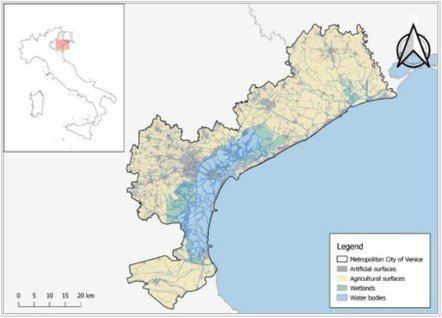A climate resilient Venice: how to meet the challenge
Physical and engineering adaptation measures are effective in the face of events such as flooding. However, some of these are too specific to tackle other extreme events – such as heat waves or pluvial floods – which are expected in the Metropolitan City of Venice. Preparing the Venice lagoon for upcoming challenges means improving the entire system’s resilience by combining different risk management initiatives, including flexible measures that are effective against a wide range of climate hazards. A study by the CMCC Foundation and Ca’Foscari University Venice.
Increases in climate-change related impacts are giving rise to environmental, economic, and social stress on coastal systems. These climate-related threats may be exacerbated by land use transformations, urbanization, over-tourism, sociopolitical tensions, and technological innovations among others.
The Metropolitan City of Venice and its lagoon, located in the north-east of Italy, along the Adriatic coast, is a coastal-urban system that is facing multiple challenges related both to changes in global phenomena and socioeconomic dynamics.
With the aim of enhancing overall system resilience to multiple climate-related disasters and a variety of other stressors, researchers at CMCC@Ca’Foscari, the strategic partnership between CMCC Foundation and Ca’ Foscari University of Venice, have conducted a study that identifies the best risk management initiatives for the area. Given the context of high uncertainty caused by climate change, the main objective was to identify robust initiatives across a range of possible future scenarios.
The Prioritization of Resilience Initiatives for Climate-Related Disasters in the Metropolitan City of Venice study has been conducted in the context of ‘BRIDGE’, a project of great relevance for the cooperation between Italy and the United States, coordinated by Andrea Critto, Professor at Ca’Foscari University of Venice and Senior Scientist at the CMCC. It concludes that, given the situation of uncertainty, the best possible strategy is to use a portfolio of risk-management initiatives – instead of a single initiative – to enhance the resilience of the whole system. This set of measures should include physical initiatives – such as the adaptation of hydraulic defense structures to cope with large scale and intense events – together with cognitive and social initiatives – such as updating and implementation of plans and regulations – which can be flexible enough to be effective against a range of hazards.
The study integrates qualitative information – derived from the involvement of stakeholders in a workshop – and quantitative information derived from climate sciences (i.e., climate-change projections).
At first, different groups of local stakeholders, including local authorities, civil protection agencies, research institutions, parks and NGOs identified the critical components of the system (natural, cultural, social, and economic) that should be protected in the area.
Secondly, stakeholders and experts identified a set of policy initiatives to support these critical functions, divided into: Information initiatives (early warning systems and information production and sharing); physical initiatives (green and blue infrastructure networks, adaptation and optimization of the water network and supply, adaptation of hydraulic defense structures and emergency response arrangements); cognitive initiatives (updating and implementation of plans and regulations, civil protection machine planning; as well as plans and strategies for restoration and recovery of historical areas); and social initiatives (environmental education and awareness and citizen science).
Finally, the above risk management initiatives were ranked, through a scenario-informed MultiCriteria Decision Analysis (MCDA), across four scenarios describing main climate threats expected in the area: storm surges, pluvial floods, heatwaves and drought.
Results show that different climate scenarios, when analyzed individually, lead to a specific prioritization of the set of risk management initiatives. Likewise, the priority of initiatives changes when considering the joint occurrence of several scenarios. However, given the large uncertainty in predicting which hazard scenarios may occur in the future in this particular area, the best option is to build overall resilience of coastal systems in the face of a range of adverse events.
The management alternatives acting on the physical domain, despite being considered a priority by stakeholders, generally only enhance resilience across a few scenarios. These results can be explained by the fact that physical initiatives are usually designed and implemented targeting very specific typologies of extreme climate events. For example, the design of hydraulic defense structures and the implementation of emergency response arrangements including set infrastructural projects like the MOSE – (MOdulo Sperimentale Elettromeccanico) or temporary solutions (e.g. footbridges, pumps and mobile bulkheads on private buildings and doors) are specifically designed for the protection of the Metropolitan City of Venice from storm surge and high waters events, while lacking any ability to increase the system resilience in relation to other kinds of hazard, such as drought and heatwaves.
On the contrary, cognitive, informative, and social initiatives seem to be more stable under changing conditions, as they maintain their position when climate change scenarios are introduced.
Implementing initiatives strongly oriented to cope with specific hazards could lead to an increase of a risk toward other kinds of hazards (i.e., maladaptation) thus undermining efforts and resources invested for risk reduction. Accordingly, the study recommends the adoption of a portfolio of risk-management initiatives to enhance the resilience of the system. These should include physical initiatives to cope with large scale and intense events, together with cognitive and social ones which can be flexible enough to be effective against a range of hazards.
“Climate risks are interconnected and do not occur in isolation” says Silvia Torresan, co-director of the Risk Assessment and Adaptation Strategies Division at the CMCC Foundation. “If we don’t employ a multi-risk approach in the assessment and management of risks, we could adopt measures that address one problem but generate or amplify others.”
